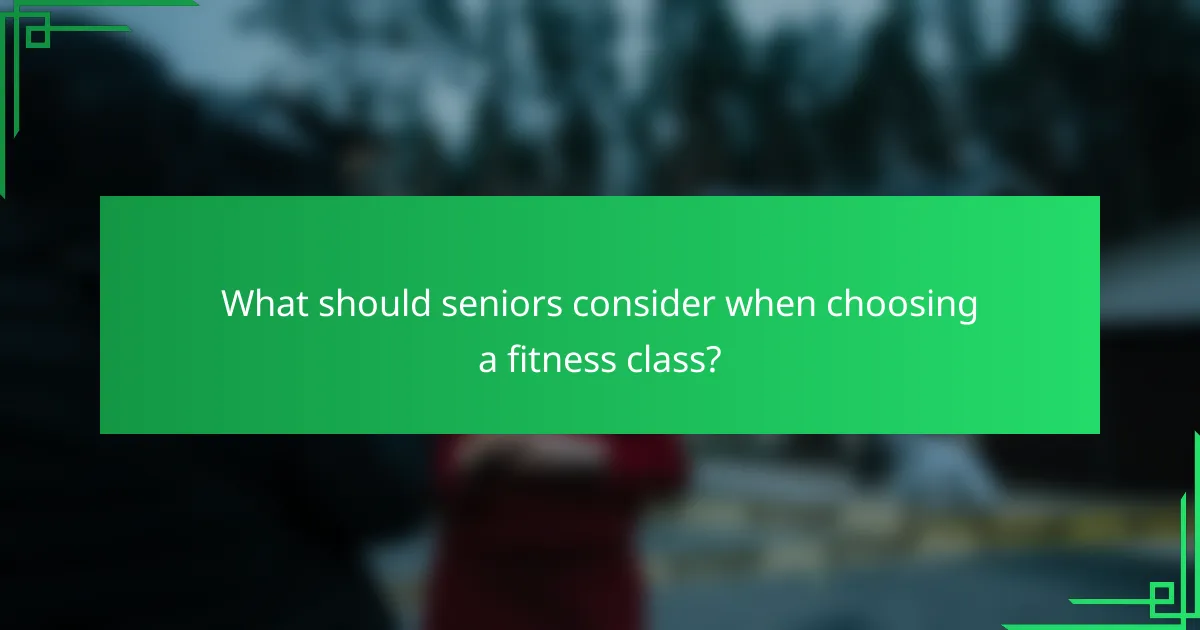Senior fitness classes are designed to promote physical health through age-appropriate, low-impact exercises that are gentle on the joints. These classes not only enhance mobility and overall fitness but also foster social engagement, allowing older adults to connect and interact with their peers. Programs like SilverSneakers and offerings at local community centers provide a supportive environment tailored to the unique needs of seniors.

What are the best senior fitness classes in major US cities?
The best senior fitness classes in major US cities focus on low-impact exercises that promote physical health while encouraging social engagement. Options like SilverSneakers, YMCA programs, and local community center offerings provide a variety of classes tailored to the needs of older adults.
SilverSneakers classes
SilverSneakers classes are designed specifically for seniors, offering a range of low-impact workouts that include strength training, yoga, and aerobics. Many gyms and fitness centers across the US participate in this program, often at no additional cost for members of participating health plans.
Classes typically last around 45 minutes to an hour and emphasize flexibility, balance, and overall fitness. Participants can expect a supportive environment that fosters social interaction, making it easier to meet new friends while staying active.
YMCA senior fitness programs
The YMCA offers a variety of senior fitness programs that cater to different fitness levels and interests. These programs often include water aerobics, chair yoga, and strength training, all designed to be safe and effective for older adults.
Membership at the YMCA usually provides access to these classes, which are often scheduled throughout the week. Many locations also offer discounts for seniors, making it an affordable option for maintaining an active lifestyle.
Local community center offerings
Local community centers frequently host senior fitness classes that are both accessible and affordable. These classes may include activities like tai chi, dance, and walking groups, which encourage movement in a social setting.
Prices for community center classes are typically lower than those at private gyms, and many centers offer drop-in rates or memberships. Check with your local community center for schedules and specific offerings, as these can vary widely by location.

How do low-impact exercises benefit seniors?
Low-impact exercises are particularly beneficial for seniors as they minimize stress on joints while promoting physical activity. These exercises enhance overall fitness, support mobility, and foster social engagement, making them ideal for older adults.
Reduces injury risk
Low-impact exercises significantly lower the risk of injuries among seniors by avoiding high-stress movements that can lead to falls or strains. Activities such as swimming, cycling, and walking are gentle on the body while still providing effective workouts.
To further reduce injury risk, seniors should focus on proper form and gradually increase intensity. Engaging in classes led by certified instructors can ensure exercises are performed safely and effectively.
Improves joint health
Participating in low-impact exercises can enhance joint health by promoting flexibility and strengthening the muscles around the joints. This is crucial for seniors, as joint issues like arthritis are common in older age.
Activities such as yoga or tai chi not only improve joint mobility but also encourage better posture and balance. Seniors should aim for at least 150 minutes of moderate activity each week, incorporating a variety of low-impact exercises to maintain joint function.

What types of senior fitness classes promote social engagement?
Senior fitness classes that encourage social engagement include activities that foster interaction and community among participants. These classes often focus on low-impact exercises while providing a supportive environment for seniors to connect with others.
Group yoga sessions
Group yoga sessions are an excellent way for seniors to enhance flexibility and balance while promoting social interaction. These classes typically involve gentle poses and breathing exercises, making them accessible for various fitness levels.
In a group setting, participants can share experiences and support each other, creating a sense of camaraderie. Look for classes that emphasize community, such as those held in local community centers or senior centers, which often offer affordable rates.
Dance classes for seniors
Dance classes for seniors provide a fun and engaging way to stay active while meeting new people. Styles such as line dancing, ballroom, or Zumba Gold are popular choices that cater to older adults, focusing on rhythm and movement without high-impact stress on the joints.
These classes not only improve physical fitness but also encourage socialization through partner work and group routines. Many community centers and fitness studios offer discounted rates for seniors, making it easier to participate regularly.

What should seniors consider when choosing a fitness class?
Seniors should prioritize class intensity, instructor qualifications, and location accessibility when selecting a fitness class. These factors ensure that the program is safe, effective, and convenient for their needs.
Class intensity level
Class intensity level is crucial for seniors to avoid injury and ensure a positive experience. Low-impact classes, such as water aerobics or chair yoga, are often ideal, as they reduce strain on joints while promoting mobility and strength.
When evaluating intensity, consider personal fitness levels and any existing health conditions. A good rule of thumb is to choose classes that allow for conversation while exercising, indicating a moderate intensity.
Instructor qualifications
Qualified instructors are essential for creating a safe and effective fitness environment for seniors. Look for instructors who have certifications in senior fitness or experience working with older adults.
Instructors should be knowledgeable about modifications for various exercises and able to address specific health concerns. Asking about their training background and experience can help ensure they are well-equipped to lead a senior fitness class.
Location accessibility
Location accessibility is vital for seniors to attend classes regularly. Choose a facility that is easy to reach, whether by car, public transport, or walking. Consider parking availability and any potential mobility challenges.
Additionally, check if the facility is equipped with features like ramps, elevators, and accessible restrooms. These factors contribute to a more comfortable and enjoyable experience for seniors participating in fitness classes.

How can technology enhance senior fitness classes?
Technology can significantly enhance senior fitness classes by providing accessible platforms for participation and tools for tracking progress. These innovations help seniors engage socially while maintaining their fitness routines in a safe and effective manner.
Virtual fitness platforms
Virtual fitness platforms allow seniors to join classes from the comfort of their homes, making fitness more accessible. These platforms often offer a variety of classes tailored to different fitness levels, including low-impact options suitable for older adults.
When selecting a virtual fitness platform, consider user-friendly interfaces and options for live interaction with instructors. Popular platforms may include Zoom for live classes or specialized apps that focus on senior fitness, providing a sense of community and motivation.
Wearable fitness trackers
Wearable fitness trackers can help seniors monitor their physical activity, heart rate, and overall health metrics. These devices encourage regular movement by providing reminders and tracking progress towards fitness goals.
When choosing a fitness tracker, look for features that cater to seniors, such as large displays and simple navigation. Many trackers also offer smartphone compatibility, allowing users to share their data with family members or healthcare providers for additional support.

What are the emerging trends in senior fitness?
Emerging trends in senior fitness focus on age-appropriate, low-impact activities that promote social engagement and overall well-being. These trends emphasize holistic approaches, combining physical activity with mental and emotional health strategies.
Mind-body fitness integration
Mind-body fitness integration is gaining popularity among seniors as it combines physical exercise with mental focus and relaxation techniques. This approach often includes practices like yoga, tai chi, and Pilates, which enhance flexibility, balance, and mindfulness.
When participating in mind-body fitness classes, seniors can improve their physical health while also reducing stress and anxiety. These classes typically involve gentle movements and breathing exercises that cater to various fitness levels, making them accessible to a wide range of participants.
To get started, seniors should look for local community centers or fitness studios offering specialized classes. It’s advisable to consult with a healthcare provider before beginning any new fitness program, especially if there are existing health concerns. Regular participation can lead to significant improvements in both physical and mental health.
